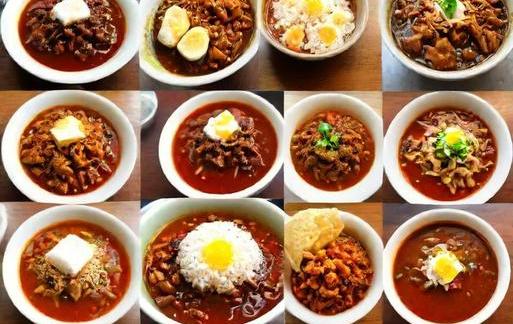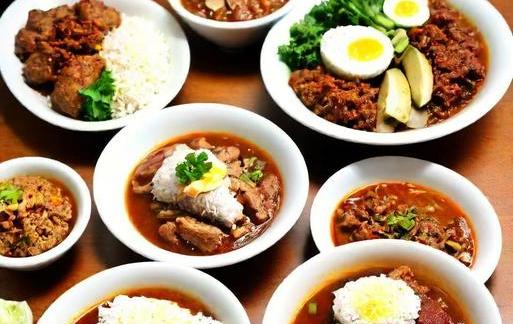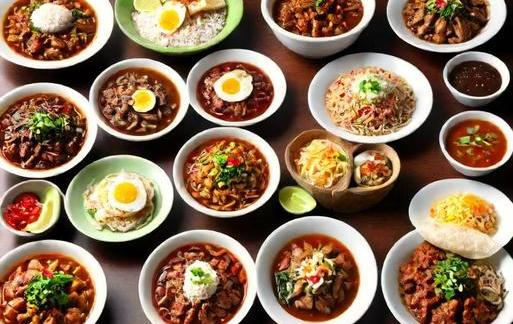- You are here:
- Home »
- Food
- » [REVEALED] Filipino Foods That Start With K
[REVEALED] Filipino Foods That Start With K
Note: This page contains affiliate links.
As an Amazon Associate, I earn from qualifying purchases when you click on the link, but you are not charged extra.
Filipino cuisine is a delightful tapestry of flavors, a fusion of indigenous, Spanish, Chinese, and American influences. Exploring the rich culinary landscape of the Philippines is a journey that unveils a plethora of unique dishes, each with its own story and cultural significance. In this gastronomic exploration, we turn our attention to Filipino foods that start with the letter "K." From savory to sweet, from street food to festive delicacies, these dishes showcase the diversity and vibrancy of Filipino cooking.
Contents
- 1 List Of Filipino Foods That Start With K
- 1.1 1. Kare-Kare (Oxtail Stew In Peanut Sauce)
- 1.2 2. Kakanin (Rice Cakes)
- 1.3 3. Kinilaw (Raw Fish Salad)
- 1.4 4. Kamote Cue (Caramelized Sweet Potatoes On A Stick)
- 1.5 5. Kaldareta (Filipino Beef Stew)
- 1.6 6. Kapeng Barako (Batangas Coffee)
- 1.7 7. Kwek-Kwek (Quail Eggs)
- 1.8 8. Kadyos Baboy Langka (KBL)
- 1.9 9. Kakanin Sa Gata (Sweet Rice Cakes In Coconut Milk)
- 1.10 10. Keso Ice Cream (Cheese Ice Cream)
- 2 Significance
- 3 Category-Related
- 4 Common Themes
- 5 Interesting Facts
- 6 Conclusion
List Of Filipino Foods That Start With K

1. Kare-Kare (Oxtail Stew In Peanut Sauce)
Kare-Kare is a Filipino stew known for its rich, savory, and slightly sweet peanut sauce. Oxtail, tripes, and sometimes pork hocks are simmered until tender, creating a hearty base. The defining element of Kare-Kare is the thick peanut sauce, which is a harmonious blend of ground peanuts and annatto seeds for a unique flavor and vibrant orange color. Vegetables such as banana hearts, string beans, and eggplants add freshness and texture. Traditionally served with bagoong (fermented shrimp paste), Kare-Kare is a mainstay during celebrations and special occasions.
2. Kakanin (Rice Cakes)
Kakanin refers to a variety of traditional Filipino rice cakes, often enjoyed as snacks or desserts. These delightful treats come in different shapes, sizes, and flavors. Notable examples include:
-
Kutsinta: A steamed rice cake made from a mixture of rice flour, brown sugar, and lye water. Its chewy texture and distinct taste make it a popular street food.
-
Kalamay: A sweet, sticky rice cake made from glutinous rice, coconut milk, and sugar. It comes in various flavors like kalamay ube (purple yam) and kalamay mais (corn).
-
Kutsinta: Bite-sized, deep-fried rice cakes coated with caramelized sugar. They are crunchy on the outside and soft on the inside, making them a delightful snack.
3. Kinilaw (Raw Fish Salad)
Kinilaw is a Filipino version of ceviche, a dish that features raw fish or seafood marinated in vinegar, calamansi (Filipino lime), ginger, onions, and chili. The acidity of the marinade "cooks" the fish, resulting in a refreshing and zesty flavor. Common choices for kinilaw include tanigue (Spanish mackerel), tuna, or even shrimp. Garnished with green mango strips and served with crispy fried fish skin, kinilaw is a popular appetizer enjoyed across the archipelago.
4. Kamote Cue (Caramelized Sweet Potatoes On A Stick)
Kamote Cue is a popular street food and merienda (snack) option in the Philippines. It features sweet potatoes skewered on sticks, coated in brown sugar, and deep-fried until caramelized. The result is a delightful combination of sweetness and earthiness. Often sold by street vendors, Kamote Cue is a comforting and affordable treat enjoyed by both young and old alike.
5. Kaldareta (Filipino Beef Stew)
Kaldareta is a hearty Filipino stew that features tender beef chunks simmered in a flavorful tomato-based sauce. Potatoes, carrots, and bell peppers are added to enhance the stew’s texture and taste. Often seasoned with a combination of garlic, onions, and bay leaves, kaldareta showcases the Filipino love for savory and comforting dishes. This stew is commonly served during family gatherings and festive occasions.
6. Kapeng Barako (Batangas Coffee)
Kapeng Barako is a type of coffee that hails from the Batangas region of the Philippines. It is known for its strong, bold flavor and distinct aroma. The coffee beans used for Kapeng Barako are Liberica beans, which are larger and have a more robust taste compared to other coffee varieties. Often enjoyed as a morning pick-me-up, this Filipino coffee is an integral part of Batangueño culture and a testament to the country’s coffee heritage.
7. Kwek-Kwek (Quail Eggs)
Kwek-Kwek is a popular street food that features quail eggs coated in orange-colored batter and deep-fried until crispy. Served with a side of vinegar-based dipping sauce, kwek-kwek offers a delightful contrast between the crunchy exterior and the tender quail eggs inside. The name "kwek-kwek" is derived from the sound made by vendors as they call out to attract customers. This affordable and portable snack is a favorite among locals, especially during festivals and events.
8. Kadyos Baboy Langka (KBL)
KBL is a classic Ilonggo dish that brings together kadyos (pigeon peas), baboy (pork), and langka (jackfruit) in a savory stew. The combination of these ingredients creates a medley of flavors and textures – the earthiness of pigeon peas, the richness of pork, and the subtly sweet notes of jackfruit. Often seasoned with fish sauce and simmered until the flavors meld, KBL is a comforting dish that showcases the diverse agricultural products of the region.
9. Kakanin Sa Gata (Sweet Rice Cakes In Coconut Milk)
Kakanin Sa Gata is a delightful dessert that combines the sweetness of rice cakes with the richness of coconut milk. Various kakanin, such as biko (sweet rice cake), sapin-sapin (layered rice cake), and suman (sticky rice cake), are cooked in coconut milk and sweetened with brown sugar. The result is a luscious and creamy dessert that reflects the tropical flavors of the Philippines. Kakanin Sa Gata is often enjoyed during fiestas, celebrations, and family gatherings.
10. Keso Ice Cream (Cheese Ice Cream)
Keso Ice Cream is a unique Filipino ice cream flavor that combines the creamy goodness of ice cream with the savory taste of cheese. This unconventional flavor has gained popularity for its unexpected yet delightful blend of sweet and salty. The cheese used in keso ice cream varies, with some recipes incorporating local cheeses like kesong puti (white cheese) for a distinct Filipino twist. This ice cream is a testament to the Filipino penchant for creative and bold culinary experiments.
Exploring Filipino foods that start with the letter "K" reveals a captivating array of flavors, textures, and culinary traditions. From the savory delights of Kare-Kare and Kaldareta to the sweet indulgence of Kakanin Sa Gata and Keso Ice Cream, each dish tells a story of Filipino ingenuity and cultural diversity. Whether enjoyed on the bustling streets of Manila or in the warmth of a family kitchen, these dishes contribute to the vibrant tapestry of Filipino cuisine. So, the next time you find yourself on a culinary adventure in the Philippines, don’t forget to savor the unique delights that start with the letter "K."
Significance

Filipino cuisine is a vibrant and diverse tapestry of flavors, reflecting the rich cultural history of the Philippines. From savory to sweet, Filipino dishes are known for their unique combinations of ingredients and meticulous preparation. In this culinary exploration, we focus on Filipino foods that start with the letter “K”, uncovering the hidden gems that contribute to the country’s gastronomic treasure. Each dish is a testament to the Filipino passion for food and the art of cooking.
Understanding the significance of Filipino foods that start with ‘K’ requires delving into the cultural and historical context of the Philippines. The archipelago, consisting of over 7,000 islands, has been a melting pot of various influences, including Malay, Chinese, Spanish, and American. This rich blend has given rise to a unique culinary identity that embraces diversity.
Filipino cuisine is not merely about sustenance; it is a cultural expression deeply rooted in the country’s history and traditions. The importance of sharing meals with family and friends, known as "kainan," is a cornerstone of Filipino social life. By exploring foods that start with “K”, we gain insight into the culinary landscape that has evolved over centuries.
Category-Related

1. Kare-Kare
Description: Kare-Kare is a Filipino oxtail stew known for its rich and savory peanut sauce. This dish is often accompanied by a variety of vegetables such as banana hearts, eggplants, and string beans. It is typically served with bagoong (fermented shrimp paste) on the side.
Ingredients:
- Oxtail
- Peanut butter
- Annatto seeds (achuete)
- Various vegetables (banana hearts, eggplants, string beans)
- Bagoong (fermented shrimp paste)
Preparation:
Kare-Kare involves a slow-cooking process to tenderize the oxtail. The peanut sauce is prepared by sautéing ground peanuts and peanut butter, giving the dish its distinct flavor. Annatto seeds are used to add color to the sauce. The vegetables are blanched separately and added to the stew.
Cultural Significance:
Kare-Kare is often associated with special occasions and celebrations. Its complex flavors and unique blend of ingredients make it a favorite among locals and a dish that showcases Filipino culinary ingenuity.
2. Kinilaw
Description: Kinilaw is a Filipino ceviche, featuring raw fish or seafood marinated in vinegar, citrus juices, and spices. It is often garnished with onions, ginger, and chili peppers, providing a refreshing and zesty flavor.
Ingredients:
- Fresh fish or seafood (usually tuna or tanigue)
- Vinegar
- Calamansi or lime juice
- Ginger
- Red onions
- Chili peppers
Preparation:
The key to a good Kinilaw is using the freshest seafood. The raw fish is mixed with vinegar and citrus juices, which effectively "cooks" the seafood through a process of denaturation. The dish is then seasoned with ginger, onions, and chili peppers, offering a delightful contrast of textures and flavors.
Cultural Significance:
Kinilaw is a dish deeply rooted in Filipino coastal communities, where fresh seafood is abundant. It reflects the Filipino love for simple yet flavorful dishes, and it is often enjoyed as a pulutan (appetizer) during social gatherings.
3. Kakanin
Description: Kakanin refers to a variety of Filipino rice cakes that come in different shapes, colors, and flavors. These sweet delicacies are often made from glutinous rice and coconut milk, showcasing the country’s love for desserts.
Examples of Kakanin:
- Kutsinta: Orange-colored rice cake with a jelly-like texture, often served with grated coconut.
- Kalamay: Sticky rice cake with a sweet, gooey consistency, sometimes flavored with coconut or chocolate.
- Kapit: Rice cake wrapped in banana leaves, usually served during festivals.
Ingredients:
- Glutinous rice
- Coconut milk
- Sugar
- Various flavorings (annatto, chocolate, pandan)
Preparation:
Kakanin involves a process of steaming or boiling glutinous rice mixed with coconut milk and sugar. The result is a delightful array of sweet treats that cater to different tastes and occasions.
Cultural Significance:
Kakanin is an integral part of Filipino celebrations, often served during fiestas, weddings, and other festive gatherings. It represents the creativity and resourcefulness of Filipino cooks in transforming simple ingredients into delectable desserts.
Common Themes
As we explore Filipino foods that start with “K”, certain common themes emerge, highlighting the distinctive characteristics that unite these dishes:
1. Coconut As A Staple Ingredient
A common thread among many Filipino foods that start with ‘K’ is the use of coconut in various forms. Whether it’s coconut milk in Kakanin or grated coconut as a topping for Kutsinta, the coconut’s versatile flavor adds a rich and tropical dimension to Filipino cuisine.
2. Balancing Act Of Flavors
Filipino cuisine is renowned for its ability to balance sweet, salty, sour, and umami flavors in a single dish. This is evident in Kinilaw, where the acidity of vinegar and citrus is balanced with the sweetness of fresh seafood. Similarly, Kare-Kare achieves a delicate equilibrium with its savory peanut sauce and the natural sweetness of vegetables.
3. Celebration Of Fresh Ingredients
The emphasis on fresh and locally sourced ingredients is a recurring theme in Filipino cuisine. Kinilaw exemplifies this with its reliance on the freshest seafood, while Kakanin highlights the use of locally grown glutinous rice and coconuts. This celebration of freshness contributes to the vibrant and dynamic nature of Filipino dishes.
Interesting Facts
1. Influence Of Indigenous Ingredients
Many Filipino dishes, including those that start with “K”, incorporate indigenous ingredients that have been part of the local culinary landscape for centuries. For example, the use of annatto seeds in Kare-Kare not only adds color but also reflects the influence of native Filipino spices.
2. Regional Variations
The Philippines’ diverse geography and cultural influences have led to regional variations in the preparation of dishes. Kare-Kare, for instance, may vary in ingredients and preparation style from one region to another, showcasing the adaptability of Filipino cuisine.
3. Innovation In Kakanin
While traditional Kakanin recipes have been passed down through generations, contemporary chefs are bringing innovation to these classic desserts. Modern twists, such as chocolate-flavored Kalamay or pandan-infused rice cakes, demonstrate the evolving nature of Filipino culinary creativity.
Conclusion
Filipino foods that start with ‘K’ offer a glimpse into the heart and soul of the country’s culinary heritage. From the complex flavors of Kare-Kare to the refreshing simplicity of Kinilaw and the sweet indulgence of Kakanin, these dishes encapsulate the diversity and richness of Filipino cuisine. The significance of these foods goes beyond mere sustenance; they are a cultural expression, a celebration of fresh ingredients, and a testament to the Filipino art of balancing flavors.
As we savor the unique tastes of these dishes, we also recognize the influence of indigenous ingredients, regional variations, and the innovative spirit that continues to shape Filipino gastronomy. Exploring Filipino foods that start with ‘K’ is not just a culinary journey; it’s a voyage through history, tradition, and the unwavering love that Filipinos have for their food. So, whether you’re indulging in the hearty warmth of Kare-Kare or relishing the vibrant flavors of Kinilaw, each bite is a celebration of the Philippines’ culinary excellence.


